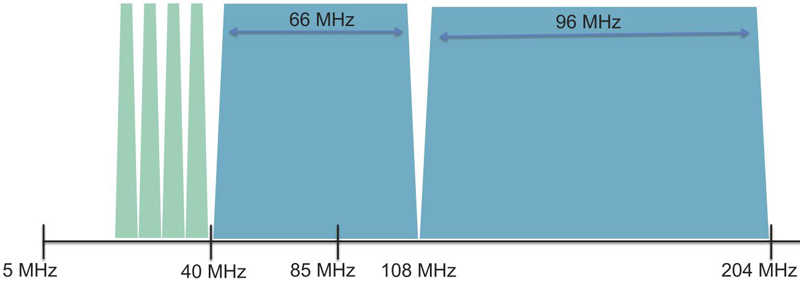How to Offer 1 Gbps Upstream Speed Today …204 MHz is the solution
By John Downey
We all know the downstream (DS) demand went up significantly over the last year and a half with over-the-top (OTT) video like Netflix and others, along with home exercise and gaming, but upstream (US) demand also went up. This was from gaming, DS video creating US ACKs, teleconferencing with video, Ring doorbells, home security cameras, home schooling, etc.
We “band-aided” the US with the tools at our disposal such as: OFDMA, maybe removed a few ATDMA signals for OFDMA, implemented more ATDMA signals in “not-so-clean” spectrum, controlled abusers, etc. Now we need to be a bit more proactive and plan for even more US demand or at least be able to offer higher US peak speeds to stay competitive.
Here is where we look at what can be done today to provide a 1 Gbps US potential service offering where 204 MHz is the solution. D3.1 CMTSs and CMs on the market today should support 204 MHz US, but the internal diplex filters need to be verified for support and automatic switching between 42, 65, 85 and 204 MHz. There’s even a 117 MHz option that typically isn’t talked about but is there.
Let’s start with some assumed truths for an extended US split and how to address potential issues.
Assumed truths
- “Greenfield” will probably be some form of FTTH or N+0, but what about video and the upfront costs? If video is a complete IP video solution, then this becomes more palatable. RF over glass (RFoG) could be utilized for video, but now we have two networks and OFDMA will not play nice with RFoG. This is a topic for another day.
- “Brownfield” upgrades, which is the focus of this article, should be as least intrusive as possible. Utilize existing cable as much as possible and no re-connectorization. No respacing of amplifiers if possible, no re-distribution of power (or very limited) and tap upgrades needed but hopefully no cable cuts or extended taps required. Conditioned taps will probably be required for US tilt and level issues. More on this topic later.
- DOCSIS 4.0 FDD includes extended spectrum DOCSIS (ESD) and focuses on the DS, but the whole reason to extend DS is to open up the US, so let’s not lose focus on that. Another term I have been using, “RF is Relevant Again!” Too bad we seem to be losing lots of RF experience lately to retirement.
So, we find ourselves in familiar territory, “Analysis Paralysis” once again! Ultimately, we need to offer a solution that will require hardware installed one more time and last for 10 years or so and deliver speeds required: ~ 10 Gbps DS and maybe 2-5 Gbps US at a reasonable cost! One more upgrade and retire 🙂
The ability to change the US/DS split automatically would be awesome, but everything comes at a price. The wasted spectrum from higher US/DS splits is more than one might think. Approximately 25% diplex filter overhead is needed — as calculated from highest US frequency. Granted, diplex filter wasted BW may not be a big deal when extending the DS to 1.8 GHz, but we’re trying to stay at 1 GHz to 1.2 GHz to minimize plant changes. Another issue with split upgrades would be many amplifier switches needed and/or manual visits to housings for future frequency split changes.
Approximately five blocks of D3.1 OFDM (1 GHz of spectrum) is needed for 10 Gbps. DS from 600 MHz to 1.8 GHz would be sufficient, but let’s focus on today. 258 MHz to 1.2 GHz still allows five blocks, but now we’re talking about OFDM in your entire DS spectrum. Shifting to US, assuming two to four SC-QAM and OFDMA up to 204 MHz, we can achieve ~ 1.5 Gbps aggregate US speed and offer a 1 Gbps service.
Let’s look at what I believe are some prerequisites to our conundrum.
Prerequisites and potential issues
- Distributed access architectures (DAA) are inevitable, whether in the form of remote PHY, remote MAC-PHY or another variant. High US spectrum may not work with analog links because of laser clipping. Some testing is being done, but optimization is required. It also may not provide the performance needed for higher D3.1 modulation orders especially with longer link budgets.
-
- Note: Always view below 5 MHz for AM broadcast radio ingress (0.5 to 1.7 MHz) and/or ham radio ingress near 1.8 MHz and 3.5 MHz.
-
- DAA translates to no analog US or DS carriers. DS analog overlay can be costly and more noise contribution unless filtering used.
- Enhanced digital return (EDR) to 204 MHz may or may not make sense when all the pros and cons are weighed.
- Address legacy set-top box (STB) out-of-band (OOB) signaling by removing legacy STBs! This one may be hard to swallow, but an upgrade to 85 MHz or 204 MHz may offer no other choice except possibly using a higher frequency and down-converting at the house.
- There will be a need to remove/replace feeder in-line equalizers, subscriber drop pad/EQs (whether standalone or in tap) and drop/home amplifiers.
- Adjacent device interference (ADI) can affect STB AGC and analog TV intermediate frequencies (IF). Service providers can install filters in the house where needed just like we’ve done for MoCA support. Another more costly option, but more permanent, would be a household architectural change. Implement drop cable to the ground block to a home gateway and use Wi-Fi and Ethernet throughout the house, removing all coax.
- Passives (splitters, couplers, feeder taps) can generate high levels of passive device intermodulation (PDI) distortion when hit with high US Tx levels. Choose wisely and test.
- FM-band (88 MHz to 108 MHz) potential interference along with over-the-air digital broadcast channels.
- And the big one: leakage testing. How do we address leakage which is usually done in the 108 MHz to 137 MHz aeronautical band when our US is 5 MHz to 204 MHz? Leakage testing in a DAA environment is addressed by generating test signals in the R-PHY node, but now we have a spectrum issue. CableLabs provides a sounding technique in FDX using the OUDP method which might address this concern. D3.1 CMs will generate the required leakage tones which can be synchronized with newer test equipment to document, track, and locate leakage.
- I’m not trying to pile on, but we also have to deal with CPE (CMs) that will support 42 MHz, 85 MHz and 204 MHz in the same plant and could have issues locking properly on the correct US bonding group. It may be wise to have a smaller OFDMA block from 42 MHz to 85 MHz and another above 85 MHz to avoid some concerns. Or avoid the FM band and just do 108 MHz to 204 MHz, but then we lose out on 85 MHz to 108 MHz spectrum. There is a working group looking at this and how to create a partial mode scenario properly.
- Another concern that should be seriously addressed is higher US frequencies which will incur more loss and experience more US Tx tilt from the CMs. There is a specification that this Tx tilt cannot exceed 12 dB and is known as the dynamic range window (DRW). In regard to this issue, I offer some ideas below.
Potential fixes for higher US frequency issues
- No coax, which is impossible, but less coax is the theme.
- Conditioned taps — EQs & InvEQs for levels and DRW issues. Field equalizers (FEQs) at least mid-span if taps cannot be changed. EQs from 5 MHz to 1.2 GHz will have no cutoff and group delay or concern for diplex changes later.
- Remove narrow SC-QAM carriers that exacerbate DRW issues.
- Thermal issues aren’t a major concern when utilizing underground cable, but passives are still above ground and experience slight temperature fluctuations. US thermal EQs can also help stabilize negative fluctuations on cold days, which create a higher noise floor, assuming aerial plant. Another idea would be to implement an US AGC driven by DS AGC circuitry. Obviously cost and complexity come into play and it may only be required when we start exceeding 204 MHz US spectrum.
- D3.0 CMs with Extended Power ECN have 3 dB to 6 dB more US Tx, with a 54 dBmV max typical. D3.1 CMs have 65 dBmV total avg power equating to ~ 5 dB more power per equivalent 8-ch D3.0 CM.
- Conditioned taps are needed to avoid the CM 12 dB DRW issue or a hardline field EQ (5 MHz to 1.2 GHz) to cover standard, flat loss taps <=14 dB. Then address specific taps as required. BTW, the DRW could be dictated by the initial ranging (IR) frequency of OFDMA, so chose wisely. Tilt within the “block” should be handled by fine ranging (FR) and pre-EQ.
- IRT temperature effects, we can expect a +/- 1.5 dB swing at 200 MHz when the plant is N+1 or 2 with 2250’ of 0.500” coax and 130’ drop. With longer cascades like N+2 or 3 with 4000’ of 0.500” coax and 150’ drop, it could be more like a +/- 2.5 dB swing at 200 MHz. It’s when we start looking at 500 MHz US that things get really scary. N+2 or 3 with 4000’ of 0.500” coax and 150’ drop can create a +/- 4 dB swing at 500 MHz. We’re trying to avoid the need for US AGC/ALC, but US thermal EQs may be worthwhile for the 204 MHz solution.
- A possible solution would be to design the plant for US levels of 48 dBmV +/- 3 dB. Taps after ~ 25 dB coax (between it and the RPD) at the highest US frequency could be designed for 46 dBmV +/- 2 dB. This allocates more headroom for temperature effects. This may be a solution with conditioned taps but opening up more for standard taps may be required.
204 MHz implementation today and closing thoughts
Surgically placing RPDs at MDUs could be a quick fix and a way to “get our feet wet.” A compact 1 RU shelf with 3×6 modularity could provide three SGs for multiple risers in a building with easy powering and rack and stack capability. CPE would be placed where needed and older CPE would still work fine.
Proposals of 1.8 GHz extension to plant are expensive, the need to still support N+3 to control expenses and the lack of FDX CPE are major reasons why FDX has halted or stalled.
Craftmanship will be of utmost importance with connectors and terminations. Proactive monitoring and automation are highly desirable and let’s not overlook the power grid as part of the equation.
Potential aggregate speed 108+555+807 = 1470 Mbps

Source: Cisco Systems

John J. Downey,
Sr. CMTS Technical Leader,
Cisco Systems
John has over 27 years in the data/telecommunications/networking industry with a BS in Electrical Engineering from Penn State University. He is a Sr. CMTS Technical Leader working for Cisco Systems the last 20 years, and is currently with the company’s Cable and Mobility Business Unit (CMBU), and is listed on one patent. He spent three years with Wavetek, known as Acterna/JDSU/Viavi, and four years with C-COR Electronics (Arris/Commscope). Certifications include CCNA and CCCS. He has been an SCTE member since ’96. John also assists Brady Volpe with a monthly podcast on everything DOCSIS. Refer to https://volpefirm.com/blog-2/ for blogs and podcasts.



